
Formosa Province is a province in northeastern Argentina, part of the Gran Chaco Region. Formosa's northeast end touches Asunción, Paraguay, and the province borders the provinces of Chaco and Salta to its south and west, respectively. The capital is Formosa.

Tarija is a department in Bolivia. It is located in south-eastern Bolivia bordering with Argentina to the south and Paraguay to the east. According to the 2012 census, it has a population of 482,196 inhabitants. It has an area of 37,623 km2 (14,526 sq mi). The city of Tarija is the capital of the department.
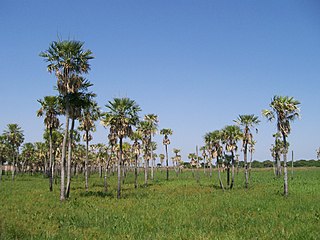
Chaco, officially the Province of Chaco, is one of the 23 provinces in Argentina. Its capital and largest city, is Resistencia. It is located in the north-east of the country.

Jujuy[xuˈxuj] is a province of Argentina, located in the extreme northwest of the country, at the borders with Chile and Bolivia. The only neighboring Argentine province is Salta to the east and south.

Salta is a province of Argentina, located in the northwest of the country. Neighboring provinces are from the east clockwise Formosa, Chaco, Santiago del Estero, Tucumán and Catamarca. It also surrounds Jujuy. To the north it borders Bolivia and Paraguay and to the west lies Chile.
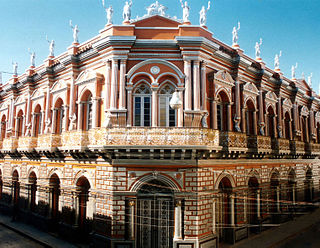
Tarija or San Bernardo de la Frontera de Tarixa is a city in southern Bolivia. Founded in 1574, Tarija is the largest city and capital and municipality within the Tarija Department, with an airport offering regular service to primary Bolivian cities, as well as a regional bus terminal with domestic and international connections. Its climate is semi-arid (BSh) with generally mild temperatures in contrast to the harsh cold of the Altiplano and the year-round humid heat of the Amazon Basin. Tarija has a population of 234,442.

The Bermejo River is a river in South America that flows from Bolivia to the Paraguay River in Argentina. The river is generally called Bermejo in spite of its different names along its way, but it also has its own Native American names; in Wichí it is called Teuco, and in Guaraní it is called Ypitá. In the plains of Argentina's Gran Chaco the Bermejo forms wetlands and splits into two branches. The southern branch is the bed of the old Bermejo River, now an intermittent stream called Río Bermejito. The northern branch is now the main stem of the Bermejo and is called the Teuco River, Bermejo Nuevo, or simply the Bermejo River. The two branches rejoin at 25°39′S60°11′W, near Villa Río Bermejito, forming the Lower Bermejo River.

The Wichí are an indigenous people of South America. They are a large group of tribes ranging about the headwaters of the Bermejo River and the Pilcomayo River, in Argentina and Bolivia.

The Argentine Northwest is a geographic and historical region of Argentina composed of the provinces of Catamarca, Jujuy, La Rioja, Salta, Santiago del Estero and Tucumán.

Tartagal is a tropical city in northern Argentina, in the province of Salta. It is located in the northeast of the province, within the General José de San Martín Department, of which it is the capital. It is located in the Yungas jungle, at the foot of the sub-Andean mountain ranges to the west and the Salta plains to the east. This location gives it a wide variety of flora and fauna, and its territory is home to eight indigenous communities. It stands out for the large density of large trees in its streets and squares, such as mangoes, algarrobos and lapachos. It is one of the few places in the world where the green macaw is not extinct in the wild.

Spanish is the language that is predominantly understood and spoken as a first, or second language by nearly all of the population of Argentina. According to the latest estimations, the population is currently greater than 45 million.
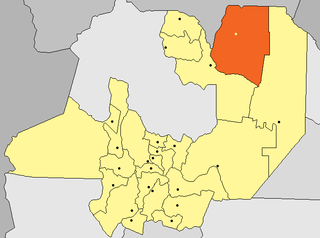
Salvador Mazza or Profesor Salvador Mazza is a city in northern Argentina, in Salta Province, 400 km (249 mi) north of the capital city of Salta, and 55 km (34 mi) from the city of Tartagal on National Route 34 in General José de San Martín Department, on the international border with Bolivia.

Aguas Calientes (Jujuy) is a town and municipality in Jujuy Province in Argentina.
Caimancito is a town and municipality in Jujuy Province in Argentina.
Cochinoca is a rural municipality and village in Jujuy Province in Argentina.

Olacapato is a village and rural municipality in Salta Province in northwestern Argentina. Olacapato is one of the highest towns in Argentina. The previous census of 2001 indicated a population of 186 inhabitants, appearing as a rural dispersed population.
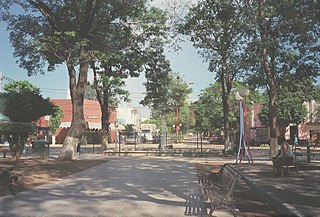
Embarcación (Salta) is a town and municipality in Salta Province in northwestern Argentina.
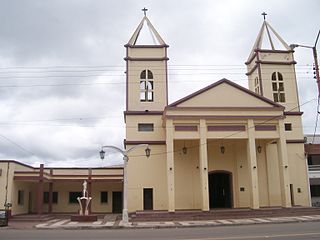
Joaquín Victor González is a town and municipality in Salta Province in northwestern Argentina. It is located in and is the capital of Anta Department. It was founded as Laguna Blanca but changed to be named after Joaquin V. Gonzalez after a railroad was built in the area. Its industries are manufacturing of wood-based goods. Its population is 21,045 with 10,567 men and 10,478 women.

The flag of Macha is the name given to a pair of flags of Argentina found at a chapel in the hamlet of Titiri, near the village of Macha, north of Potosí, Bolivia. They are considered to be the first physical flags created by Manuel Belgrano, who in November 1813 hid the standards to prevent them from falling into enemy hands after the United Provinces' army defeat of Ayohuma. They were discovered in 1885. Bolivia kept one of those flags at Sucre; the other was given to Argentina in 1896 and is currently kept at the National Historical Museum. Tucumán Province has used it as provincial flag since 2010. The flag preserved in Argentina is a triband of blue, white and blue bands, like the modern flag of Argentina, but the one kept in Bolivia is a triband of white, blue and white.

The Salta–Antofagasta railway, also named Huaytiquina, is a non-electrified single track railway line that links Argentina and Chile passing through the Andes. It is a 1,000 mmmetre gauge railway with a total length of 941 km, connecting the city of Salta (Argentina) to the one of Antofagasta (Chile), on the Pacific Ocean, passing through the Puna de Atacama and Atacama Desert.


















